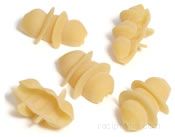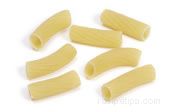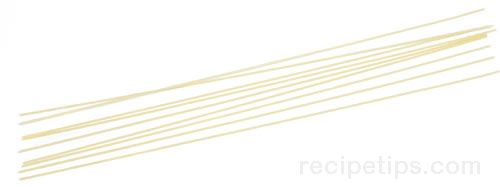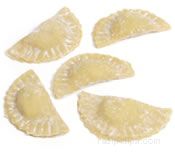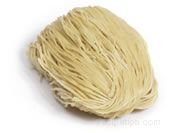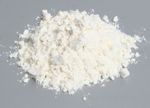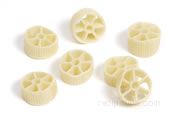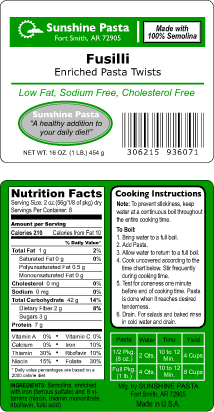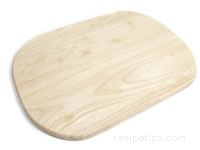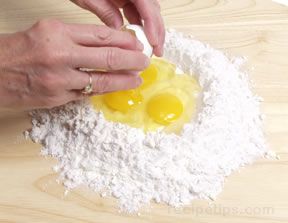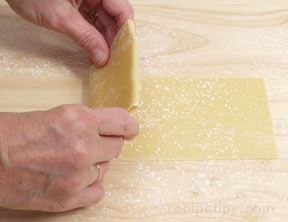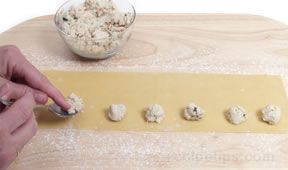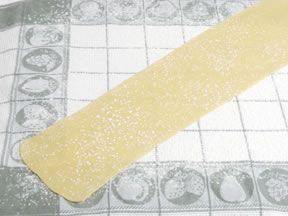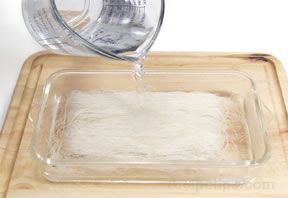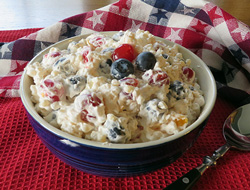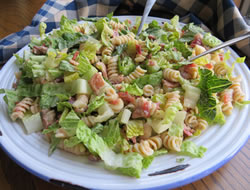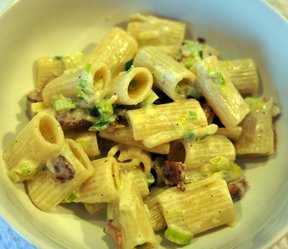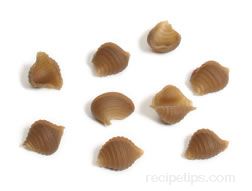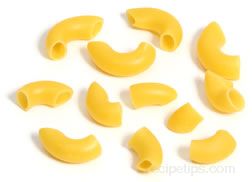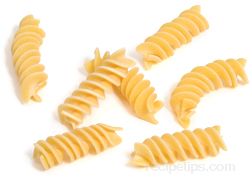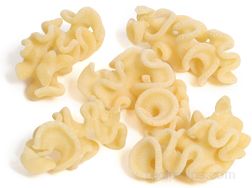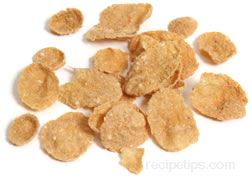|
Shaped Pasta | Tubular Pasta | Strand Pasta Noodles | Ribbon Pasta Noodles
Soup Pasta | Stuffed Pasta | Asian Noodles
There are numerous pasta products available, consisting of dried and fresh pasta. Some products are available both in a dried and fresh form but there are many more dried products than fresh. The products range in size from tiny soup pasta to large sheets of lasagne noodles. Many of the varieties of pasta are available in flavors, such as spinach, tomato, beets, saffron and squid ink. The flavors also add color to the pasta. Listed below are some of the many pasta products that are available. The cooking times shown below are only estimates due to the fact that the thickness, cooking methods and the brand of pasta can all affect the length of time it takes to cook the pasta to its proper doneness. Pasta should be cooked to its "al dente" state, which is tender but still having a slightly firm bite.
Shaped Pasta
Shaped pasta is available in many different sizes and specific shapes. Shaped pasta is generally found dried. The smaller sizes work well with a simple sauce but most shaped pastas can be paired with a chunkier sauce because they are sturdy enough to hold up with the other ingredients. They are also used in pasta salads and casseroles.
|
Shaped Pasta |
|
Pasta |
Description |
Estimated Cooking Time |
| Campanelle |
Pasta in the shape of a small cone with a ruffled edge. |
Cook for 6 to 10 minutes. |
|
Casarecci (cesariccia) |
Short lengths of pasta that have been rolled and slightly twisted.
|
Cook for 9 to 11 minutes. |
|
Cavatelli |
A small shell shaped pasta that has a slightly rolled in edge. |
Cook for 9 to 12 minutes. |
| Conchiglie (pasta shells) |
Medium sized pasta shaped similar to a conch shell. It has a ridged surface and is available in several sizes. |
Cook for 10 to 12 minutes. |
| Conchiglioni (jumbo shells) |
The largest of the conch shell shaped pastas. It is often prepared by stuffing the pasta after it is boiled and then baking it in the oven. |
Cook for 12 to 15 minutes. |
| Creste di galli (creste) |
A short, curved tubular pasta with a ruffle of pasta along the length of the outside curve. |
Cook for 10 to 12 minutes. |
| Farfalle (bow ties, butterfly pasta) |
Bow tie or butterfly shaped pasta, available in several sizes. |
Cook for 8 to 10 minutes. |
| Farfalle rotonde |
Bow tie shape pasta similar to farfalle except its ends are rounded. |
Cook for 8 to 10 minutes. |
| Farfallone |
A larger version of farfalle pasta. |
Cook for 10 to 12 minutes. |
| Fusilli col buco (pasta twists) |
A twisted pasta shape that resembles a corkscrew. |
Cook for 10 to 12 minutes. |
| Gemelli |
Pasta that consists of two short pasta strands that are twisted together into a spiral shape. |
Cook for 8 to 10 minutes. |
| Gigli (ballerine, riccioli) |
A piece of pasta with a fluted edge, that has been rolled into a cone shaped flower. |
Cook for 9 to 12 minutes. |
| Gnocchetti |
A small version of the dried variety of "gnocchi." |
Cook for 6 to 8 minutes. |
| Gnocchi |
The name given to a small potato dumpling that is made with potatoes, flour and egg, or semolina flour and egg. They can also be made with other ingredients added for flavor, such as spinach, ricotta, Parmesan, and yams. They are sold as a fresh and dried product. Fresh gnocchi is found in a variety of shapes, such as ovals, shells, cylinders and flattened disks. Dried gnocchi is generally shaped like a hollowed shell, similar to the shape of cavatelli pasta, but with a ridged surface. Fresh gnocchi generally contains potatoes and the dried gnocchi contains semolina flour and no potatoes. |
Fresh: Cook for 2 to 4 minutes, remove when the gnocchi rises to the surface.
Dried: Cook for 8 to 12 minutes. |
| Gramigna |
A thin, short, curled strand of pasta. |
Cook for 9 to 11 minutes. |
| Lumache |
Pasta shaped similar to the shell of a snail. |
Cook for 10 to 12 minutes. |
| Lumaconi |
A larger variety of lumache, which is generally prepared by stuffing the boiled pasta and then baking in the oven. |
Cook for 12 to 15 minutes. |
| Malloreddus (gnocchetti sardi) |
A Sardinian-style pasta that is shaped similar to gnocchetti only narrower and it is generally flavored with saffron. |
Cook for 10 to 12 minutes. |
| Maltagliati |
Flat pieces of roughly cut pasta pieces cut from the scraps of pasta. |
Cook for 5 to 7 minutes. |
| Margherite |
Pasta with a shaped that resembles a shell with a rippled edge. |
Cook for 10 to 12 minutes. |
| Medium egg noodle |
Short lengths of medium wide (approximately ¼ inch) twisted egg noodles. Egg noodles are also available in wide and extra wide widths. |
Cook for 6 to 8 minutes. |
| Orecchiette |
Thick disk shaped pasta that is formed into bowls or "little ears." |
Cook for 9 to 12 minutes. |
| Quadrefiore |
A thick square shaped pasta that has several lines of rippled pasta running down its length. |
Cook for 15 to 18 minutes. |
| Radiatori |
Short chunky pieces of pasta with ridges circling the pasta, which form a shape that resembles the grill of a radiator. |
Cook for 10 to 13 minutes. |
| Ricciolini |
Wide, 2-inch long pasta noodles that have a slight twist to them. |
Cook for 6 to 9 minutes. |
| Rotelle |
A wheel shaped pasta that is a smaller version of ruote. |
Cook for 8 to 10 minutes. |
| Rotini (spirals, twists) |
Short pasta twisted into a spiral shape.
|
Cook for 9 to 13 minutes |
| Ruote (ruotine, wagon wheels) |
Pasta shaped like six spoke cartwheels. |
Cook for 9 to 12 minutes. |
| Spiralini |
Strands of pasta that are coiled into a shape resembling a spring. Similar to fusilli col buco, only spiralini is shorter and coiled closer together. |
Cook for 10 or 12 minutes. |
| Strozzapreti |
Pieces of pasta that have been rolled across its width to resemble a rolled towel. |
Cook for 10 to 12 minutes. |
| Torchio |
Torch shaped pasta, which works well to scoop up the ingredients of a chunky sauce.
|
Cook for 9 to 11 minutes. |
| Trenne |
Short lengths of triangular shaped pasta that is hollow through the center. |
Cook for 10 to 12 minutes. |
| Trennette |
A smaller variety of trenne. Realize that trenette pasta is not the same as trennette. Trenette is a ribbon pasta. |
Cook for 9 to 12 minutes. |
| Troffiette |
A smaller variety of trofie. |
Cook for 9 to 12 minutes. |
| Trofie |
Pieces of pasta that have been rolled on a flat surface until it forms a rounded length of pasta that has tapered ends, which is then twisted into its final shape. A thin stick can also be used to wrap the pasta length around to assist in forming the twisted shape. |
Cook for 10 to 13 minutes. |
| Wide egg noodle |
Short lengths of wide (approximately 3/8 inch) twisted egg noodles. Egg noodles are also available in medium and extra wide widths. |
Cook for 6 to 8 minutes. |
Tubular Pasta
Tubular pasta is any pasta that is hollow through the center, forming a tube. They are available in many different sizes and shapes. Some tubes are long and narrow while others are short and wide. They are found with smooth or ridged exteriors and their ends are cut straight or at angle. They are often served with a heavy sauce, which holds well in the hollows of the pasta tubes. Tubular pasta is also used in salads and casseroles. Some of the larger tubes that have a wide opening can be stuffed with meat and/or cheese and then baked.
|
Tubular Pasta |
|
Pasta |
Description |
Estimated Cooking Time |
| Boccolotti |
A straight, short, hollow pasta. |
Cook for 8 to 12 minutes. |
|
Bucatini |
Thick spaghetti shaped pasta that is hollow in the center, similar to a thin straw.
|
Cook for 9 to 13 minutes. |
|
Calamaretti |
Wide tubular pasta that is shaped like a large ring. |
Cook for 6 to 8 minutes. |
| Canneroni |
A short, smaller version of cannelloni. |
Cook for 6 to 8 minutes. |
| Cannelloni |
A wide (approximately 1 inch), straight pasta tube that is approximately 4 inches long. It is cut straight on both ends and has a smooth surface. |
Cook for 7 to 10 minutes.
|
| Cannolicchi |
Short, straight tube pasta with a wide grooved surface. |
Cook for 11 to 13 minutes. |
| Cavatappi |
A short, S-shaped pasta tube. |
Cook for 9 to 10 minutes. |
| Cellentani |
A pasta tube that has been twisted to resembles the shape of a corkscrew. |
Cook for 9 to 12 minutes. |
| Chifferi |
Short, chunky tube pasta in a semi-circle shape.
|
Cook for 8 to 10 minutes. |
| Elbow macaroni (pipette) |
The most common tube pasta shape. It is a narrow tube with a semi-circular curved shape, which is approximately 1 inch in length. |
Cook for 8 to 10 minutes. |
| Elicoidali |
A medium sized tube pasta similar to rigatoni. It is slightly narrower than rigatoni and the ridges on the surface of elicoidali are slightly curved around the tube, rather than straight as on rigatoni. |
Cook for 10 to 12 minutes. |
| Fagioloni |
A narrow width pasta tube. It is has a mostly straight shape and is approximately 1 inch in length. |
Cook for 9 to 12 minutes. |
| Garganelli |
Fine Ribbed squares of pasta that are rolled into tubular shape. Once rolled, they take on a shape similar to penne pasta but are actually more of a scroll shape. |
Cook for 11 to 13 minutes. |
| Genovesini rigati |
A short, tube pasta similar to penne except it is only about half the length. |
Cook for 9 to 12 minutes. |
| Gomiti |
Short and chunky, c-shaped tube pasta. |
Cook for 10 to 12 minutes. |
| Macaroni |
Macaroni is used in reference to any narrow short tubular pasta. The tubes may be straight or curved in shape and vary slightly in width. The most commonly known is elbow macaroni. |
Cook for 8 to 12 minutes. Cooking time will vary according to size of the various types. |
| Maccheroni |
Long thick tube pasta. There is also a short version of this pasta, which is also known as macaroni. |
Cook longer version for 9 to 11 minutes and cook the short version for 8 to 12 minutes. |
| Maccheroni rigati |
Tubular pasta similar to macaroni only it has a ribbed surface. Maccheroni rigati is available in various sizes. |
Cook for 8 to 12 minutes. Cooking time will vary according to size of the various types. |
| Maccheroncelli |
Long tube pasta that is slightly slimmer than a pencil and has a small hollowed out center. |
Cook for 9 to 11 minutes. |
| Magliette |
A short, curved tube pasta. |
Cook for 8 to 11 minutes. |
| Manicotti |
Large tube pasta that may be found with a ridged or smooth surface and ends that are straight cut or diagonally cut. |
Cook for 7 to 10 minutes. |
| Mezzani |
A short, curved tube pasta. |
Cook for 8 to 11 minutes. |
| Mezze Penne |
Short tube pasta with diagonally cut ends. This pasta is a short, stubby version of penne. |
Cook for 9 to 11 minutes. |
| Mostaccioli |
Tube pasta with diagonally cut ends, similar to penne but longer in length. Mostaccioli is approximately 2 inches long and is available with a smooth or ridged surface. |
Cook for 10 to 13 minutes. |
| Paccheri |
Large tube pasta that contains a wide hollowed center that is approximately 1 inch in diameter. |
Cook for 7 to 10 minutes. |
| Pasta al ceppo |
Tube pasta that is created by wrapping a strip of pasta dough around a thin stick. Its shape is similar to a cinnamon stick. |
Cook for 10 to 12 minutes. |
| Penne |
Thin tube pasta with sharp, diagonally cut ends, which resemble the end of a quill pen. Penne pasta is approximately 1 to 1 1/4 inches in length. |
Cook for 10 to 12 minutes. |
| Penne rigate |
Penne pasta with a ridged outer surface. |
Cook for 10 to 12 minutes. |
| Penne a candela |
A slightly larger version of penne pasta.
|
Cook for 10 to 12 minutes. |
| Penne Zita |
A longer version of penne pasta. |
Cook for 10 to 12 minutes. |
| Pennette |
A slightly shorter and thinner version of penne pasta. |
Cook for 9 to 11 minutes. |
| Pennette rigate |
Pennette pasts with a ridged outer surface. |
Cook for 9 to 11 minutes. |
| Pennine lisce |
A thin version of penne, which is thinner than pennette. The lisce in the pasta's name indicates that it has a smooth surface. |
Cook for 8 to 11 minutes. |
| Pennoni |
A version of penne pasta that is similar in length but is larger in width. |
Cook for 10 to 13 minutes. |
| Pennoni rigati |
Pennoni pasta with a ridged outer surface. |
Cook for 10 to 13 minutes. |
| Perciatelli |
Long, tube pasta with a hollowed out center. Perciatelli is approximately double the thickness of spaghetti. |
Cook for 10 to 13 minutes. |
| Reginelle |
Tube pasta similar to penne except reginelle pasta is longer and thinner. |
Cook for 10 to 12 minutes |
| Rigatoni |
A large, slightly curved tube pasta that is approximately 1-½ inches in length. It has a ridged outer surface and straight cut ends. |
Cook for 10 to 13 minutes. |
| Spaccatelle |
Short curved tube pasta shaped similar to a half circle. |
Cook for 8 to 10 minutes. |
| Tortiglioni |
Tube pasta similar to rigatoni. Tortiglioni is narrower in width than rigatoni and its surface ridges spiral around the tube, rather than parallel to the length as they do on rigatoni.
|
Cook for 10 to 12 minutes. |
| Tufoli |
A large diameter, short tube pasta with a smooth surface. |
Cook for 7 to 10 minutes. |
| Ziti (bridegrooms) |
Tube pasta with a wide hollowed out center. It is available in long lengths and also cut to shorter lengths of 2 to 3 inches. The shorter lengths are sometimes found with a slight curve to them. |
Cook for 9 to 12 minutes, depending on size. |
| Ziti rigati |
Zita pasta with a ridged outer surface. |
Cook for 9 to 12 minutes, depending on size. |
| Zitoni |
A slightly wider version of ziti pasta. |
Cook for 9 to 12 minutes. |
Strand Pasta Noodles
Pasta strands are long rods of pasta, which are generally round, but they are available in a square rod also. The basic difference from one variety to the next is the thickness of the strands. The thicker strands work well with a heavier sauce while the thin varieties are better with a more delicate sauce.
|
Strand Pasta Noodles |
|
Pasta |
Description |
Estimated Cooking Time |
| Angel Hair (capelli d"angelo) |
Extremely thin, long strands of pasta. Available in both strands and nests. |
Cook for 2 to 4 minutes. |
|
Barbina |
A long strand pasta that is very similar to capellini. It is generally available in coiled nests.
|
Cook for 2 to 4 minutes. |
|
Bigoli |
Long strand pasta with a thickness similar to spaghetti. It has a rough surface, which helps it hold sauces better and absorb its flavor. |
Cook for 9 to 12 minutes. |
| Capelli d'angelo (Angel Hair) |
Extremely thin, long strands of pasta. Available in both strands and nests. |
Cook for 2 to 4 minutes. |
| Capellini |
Long strands of pasta that are very similar to Angel hair pasta, only slightly thicker. Available in both strands and nests. |
Cook for 2 to 4 minutes.
|
| Chitarra (spaghetti alla chitarra) |
Long pasta strands, which resembles spaghetti, except they are square instead of round. |
Cook for 10 to 14 minutes. |
| Ciriole |
A long strand of pasta that is twisted and stretched until it its approximately double the width of spaghetti. |
Cook for 7 to 10 minutes. |
| Fedelini (fidelini) |
Very thin strands of long pasta, which are slightly thicker than vermicelli. |
Cook for 5 to 7 minutes. |
| Fusilli lunghi |
Long, twisted, corkscrew shaped pasta strands. |
Cook for 10 to 12 minutes. |
| Spaghetti |
Long thin round strand pastas. |
Cook for 9 to 12 minutes. |
| Spaghettini |
A thinner version of spaghetti. |
Cook for 7 to 10 minutes. |
| Spaghettoni |
A thicker version of spaghetti. |
Cook for 10 to 13 minutes. |
| Vermicelli |
Very thin, round pasta strands, which are similar to spaghettini. They are thinner than spaghettini. |
Cook for 5 to 6 minutes. |
| Vermicelloni |
A thicker version of vermicelli. |
Cook for 9 to 12 minutes. |
Ribbon Pasta Noodles
Ribbon pasta, which is flat strands of pasta, is available in different lengths, widths and thickness. Some are short and wide, while others are long and narrow. Ribbon pasta can have straight or wavy edges and many varieties are available fresh and dried. The dried ribbons are generally used with a thick, heavier sauce and the fresh ribbons are served with a more delicate sauce.
|
Ribbon Pasta Noodles |
|
Pasta |
Description |
Estimated Cooking Time |
| Bavette |
A long, flat, narrow ribbon pasta that is similar to tagliatelle, only narrower. |
Cook for 6 to 9 minutes. |
|
Bavettine (mezze linguine) |
A narrower version of bavette.
|
Cook for 5 to 8 minutes. |
|
Fettuce |
A long, flat, wide pasta noodle, which is approximately ½ inch wide. It is generally an egg noodle. |
Cook for 8 to 10 minutes. |
| Fettuccine |
A thinner version of fettuce. Fettuccine is approximately ¼ inch wide. It is most often sold in a loosely coiled nest. |
Cook for 7 to 9 minutes. |
| Fettucelle |
The thinnest version of fettuce. It is approximately 1/8 inch wide and is most often sold as straight sticks. |
Cook for 6 to 8 minutes. |
| Lasagne |
A very wide flat pasta that is available in ribbons that are approximately 10 to 13 inches long and vary in width from 2 to 3 ½ inches. Lasagne is also available in sheets that are generally 3 ½ x 5 inches or 4 x 6 inches. The ribbons or sheets are layered in a casserole between other ingredients to make a dish called lasagne. It is available in several different styles. Some varieties of the noodles have straight edges and some have wavy edges on one or both sides. Also, some lasagne sheets have waves throughout the entire sheet running parallel to its length. |
Cook for 9 to 12 minutes. There are also a variety of lasagne noodles available that do not require precooking. |
| Lasagnette |
A narrower version of the long lasagne noodle. It can be used in a baked casserole dish or it can also be just boiled and served with a sauce. |
Cook for 7 to 10 minutes. |
| Linguettine |
A narrower version of linguine. |
Cook for 5 to 8 minutes. |
| Linguine |
Spaghetti-like pasta that has been flattened into oval-shaped or flattened ribbon pasta. Linguine is approximately 1/8 inch wide. In Italian, linguine means little tongues. |
Cook for 6 to 9 minutes.
|
| Mafalde |
A wide flat ribbon pasta that is approximately ¾ inches in width, with rippled edges on both sides. |
Cook for 9 to 12 minutes. |
| Pappardelle |
A wide flat ribbon pasta that is approximately 5/8 to 1 inch in width. It is available with straight edges or rippled edges. |
Cook for 7 to 10 minutes. |
| Pillus |
Very thin ribbons of pasta. |
Cook for 5 to 8 minutes. |
| Pizzoccheri |
Thick, flat noodles made from buckwheat. They are generally a long noodle sold in nests but are also found cut in short lengths. |
Cook for 10 to 14 minutes. |
| Reginette (reginelle) |
Wide, flat ribbon pasta, which has edges that are rippled on both sides. Reginette is similar to lasangette. |
Cook for 7 to 10 minutes. |
| Sagnarelli |
A short, flat pasta ribbon, which is approximately 1 ¾ to 2 inches in length with fluted edges on all sides. |
Cook for 7 to 11 minutes. |
| Stringozzi |
Narrow Umbrian pasta ribbons that are thicker than spaghetti and look similar to shoestrings. It is a narrow ribbon that is thicker than spaghetti and has a chewier texture. |
Cook for 11 to 14 minutes. |
| Tagliatelle |
Long thin, ribbon pasta that is generally found ¼ to 3/8 inch in width. It can be made with or without eggs and is available in straight strands or coiled in a nest. |
Cook for 7 to 10 minutes.
|
| Taglierini (tagliolini, tonnarelli) |
A narrower version of tagliatelle. It is approximately 1/8 inch wide. |
Cook for 6 to 9 minutes. |
| Trenette (trinette) |
Ribbon pasta similar to linguine, only narrower in width. It is approximately 1/8 inch wide. |
Cook for 6 to 9 minutes. |
| Tripoline |
A wide, flat ribbon pasta that has one rippled edge and one straight edge. They are available in straight strands or coiled in a nest. |
Cook for 7 to 11 minutes.
|
Soup Pasta
Soup pasta consists of pasta shapes that range in size from small to very tiny. The larger of the soup pastas are used in thicker based soups and the tiny and smaller pasta shapes are used in light or broth based soups. Some of the soup pastas are also used in some pasta salads.
|
Soup Pasta |
|
Pasta |
Description |
Estimated Cooking Time |
| Acini di pepe (peperini) |
Very tiny beads of pasta. |
Cook for 4 to 6 minutes. |
|
Alphabets (alfabeto) |
Tiny alphabet shaped pasta. |
Cook for 5 to 9 minutes. |
|
Anelli (anelletti) |
Small rings of pasta. |
Cook for 6 to 9 minutes. |
| Anelli rigati |
Small rings of pasta with a ridged surface. |
Cook for 6 to 9 minutes. |
| Anellini |
Tiny rings of pasta. Anellini is a smaller version of Anelli. |
Cook for 5 to 6 minutes. |
| Conchigliette (baby shells) |
A tiny version of conchiglie pasta, which is pasta shaped similar to a conch shell. |
Cook for 7 to 9 minutes. |
| Coralli |
Tiny, short pasta tubes. |
Cook for 6 to 8 minutes. |
| Couscous |
A rolled wheat, grain shaped pasta that is the tiniest of all pastas. Couscous is not generally used in soups but is used in salads or as the base to a savory dish. Originally, it required cooking for hours in a steamer. It is now available as a precooked instant product. |
To cook, add couscous to a premeasured quantity of boiling water (or other liquids suggested by a specific recipe), cover, remove from heat, and let stand for 5 to 7 minutes. |
| Ditali |
Small, short-cut pasta tubes.
|
Cook for 9 to 10 minutes. |
| Ditalini |
A smaller version of the ditali tube pasta. |
Cook for 7 to 9 minutes. |
| Ditalini rigati |
Ditalini pasta with a ridged outer surface. |
Cook for 8 to 10 minutes. |
| Farfalline |
A small version of the bow-tie or butterfly shaped pasta, farfalle. |
Cook for 7 to 10 minutes. |
| Fideos |
Short thin strands of pasta which have a slight curve to them. |
Cook for 3 to 5 minutes. |
| Filini |
Very thin, short-cut strands of pasta. |
Cook for 3 to 5 minutes. |
| Funghini |
Tiny mushroom shaped pasta. |
Cook for 7 to 10m minutes. |
| Grattoni |
Tiny diamond shaped egg pasta. |
Cook for 6 to 9 minutes. |
| Occhi di pernice |
Tiny rings of pasta. |
Cook for 3 to 5 minutes. |
| Orzo (rosa marina) |
Small pasta shapes resembling rice or grain. |
Cook for 7 to 10 minutes. |
| Pastine |
Includes any of the tiny pasta shapes that are available. The pastine pasta shapes are generally used in broth based or light soups and are sometimes referred to as soup pasta. |
Cooking time varies from just a few minutes up to 13 or 14 minutes. |
| Piombi |
Small, solid beads of pasta. |
Cook for 11 to 13 minutes. |
| Quadrettini (quadrucci) |
Small, flat, square or triangle shaped pasta. |
Cook for 6 to 8 minutes. |
| Risi (risoni, pasta a riso) |
Small rice or grain shaped pasta. |
Cook for 4 to 6 minutes. |
| Seme di melone |
Small pasta shaped similar to flat melon seeds. |
Cook for 8 to 10 minutes. |
| Stelle (stellette) |
Small star shaped pasta that contains a hole through the center of the star.
|
Cook for 5 to 7 minutes. |
| Stelline |
A smaller version of stelle pasta. |
Cook for 4 to 6 minutes. |
| Stortini |
Short, curved tube pasta, which is basically a smaller version of elbow macaroni. |
Cook for 7 to 9 minutes.
|
| Tempestina |
Tiny solid beads of pasta. |
Cook for 8 to 10 minutes. |
| Tripolini (little bows) |
Generally used to describe tiny bow tie shaped pasta, but it is sometimes used to describe a wide strand of pasta that has a wavy edge on one side. |
Cook bow tie shaped pasta for 5 to 7 minutes. |
| Tubetti |
Small tubular pasta. It is similar to ditalini pasta only slightly longer in length. |
Cook for 6 to 9 minutes. |
| Tubettini |
Tiny pasta tube that is a smaller version of tubetti. |
Cook for 5 to 8 minutes. |
Stuffed Pasta
Stuffed pasta consists of fresh pasta sheets that are stuffed with a filling. After the filling has been added, the pasta sheets are folded over and sealed, or another sheet is placed on top and the edges are sealed. Some sheets are folded over the filling and then twisted to form special shapes. Stuffed pastas are formed from sheets of different shapes, such as squares, rectangles, and triangles. They are stuffed with a variety of fillings, which consist of a mixture of ingredients, such as meats, cheeses, herbs, mushrooms, and vegetables. Stuffed pastas are first cooked and then generally served with a light sauce. They can also be served in a broth, added to a baked dish, or added to a salad after they have been cooked. Stuffed pasta is generally fresh but can also be found frozen and some types can be found dried. The cooking times below are for fresh stuffed pasta. If the stuffed pasta is frozen or dried, it will take approximately 2 to 4 additional minutes to cook. Cooking times will vary depending on the thickness and size of the pasta sheet. When cooking fresh pasta, it should be watched carefully and checked for doneness once the pasta floats to the top. Check often to prevent pasta from becoming mushy.
|
Stuffed Pasta |
|
Pasta |
Description |
Estimated Cooking Time |
| Agnolotti |
A rippled edge circle or square of pasta where stuffing is added and the pasta is then folded over and sealed on the open edge to form a half circle or rectangle shape. |
Cook for 4 to 7 minutes. |
|
Cappelletti (alpine hats) |
Two inch squares of pasta that are folded in half to form a triangle after the filling is added and then twisted to form the shape of a little hat. |
Cook for 3 to 7 minutes. |
|
Manti |
A Turkish pasta that is made by adding a small ball of ground meat filling to a small pasta square and then drawing up all four corners together to form a ball shaped stuffed pasta. |
Cook for 6 to 15 minutes. Time will vary depending on thickness and size of the pasta. |
| Pansotti |
A stuffed pasta made by placing filling on a 2 inch square of pasta and then folding the square of pasta in half to form a triangle shape. The edges of the pasta may be straight or pinked. |
Cook for 4 to 9 minutes. |
| Ravioli |
A square, double layer of pasta that is stuffed with a filling between the layers to form a shape that resembles a pillow. |
Cook for 4 to 9 minutes. |
| Ravioloni |
A larger version of ravioli. |
Cook for 5 to 9 minutes. |
| Ravioletti |
A smaller version of ravioli. |
Cook for 4 to 8 minutes. |
| Tortelli (anolini) |
A stuffed pasta made by placing filling on a 2 inch circle of pasta and then folding the pasta in half to form a half circle. |
Cook for 4 to 9 minutes. |
| Tortellini |
Circles of pasta that are folded in half to form a half circle after the filling is added and then twisted to form the shape of a little hat. |
Cook for 4 to 9 minutes. |
| Tortelloni |
A larger version of Tortellini.
|
Cook for 7 to 10 minutes. |
Asian Noodles
Asian noodles consist of strands that vary in shape, width, and length. Many Asian noodles are very long in length, symbolizing longevity. They can be thin straight sticks, flat strands, round strands, and wavy strands. The noodles are made from various flours, such as wheat flour, rice flour, potato flour, soybean flour, and mung bean flour. Some Asian noodles are made with eggs but many do not contain any eggs. Many are available fresh and dried but some are only found in Asian markets. Asian noodles are a variety of colors, such as translucent white, opaque white, cream, yellow, tan and brown. The ingredients used, in the dough affects the color of the noodle. Asian noodles are eaten hot and cold, and are used in soups, salads, stir-fries, and other Asian dishes. Most Asian noodles are rinsed with cold water and drained after cooking to remove the starch.
|
Asian Noodles |
|
Pasta |
Description |
Estimated Cooking Time |
| Arrowroot Vermicelli |
Thin white, semi-transparent noodles that are made from arrowroot starch. They are similar to cellophane noodles in appearance. |
Cook for 2 to 4 minutes, until tender. |
|
Cellophane noodles (mung bean thread noodles) |
Thin translucent noodles made from mung bean starch. The dried noodles have a slippery texture when cooked. The noodles should be soaked before cooking. Cellophane noodles can also be deep-fried. They are sold in bundles.
To prepare: Soak by placing the noodles in a heatproof bowl and pouring hot or boiling water over them. Let them soak for 5 to 15 minutes, just until tender. If adding to a soup, it is not necessary to soak the noodles before adding them. Do not soak if you are deep-frying the noodles. |
Cook the noodles by adding to boiling water and cooking for 1 to 3 minutes. |
|
Chinese egg noodles (dan mien) |
Long noodles made with wheat flour and eggs. They are available as a round noodle in various thicknesses and can also be fond as a flattened noodle in various widths. Chinese egg noodles are golden yellow in color and generally found wrapped tightly in a bundle or nest. They should be cooked similar to Italian egg noodles. |
Dried noodles: Cook in boiling water for 3 to 6 minutes, depending on size. If adding to a soup, slightly undercook the noodles.
Fresh noodles: Cook for 1 to 3 minutes. If adding to a soup, fresh noodles can be added without precooking. |
| Chinese wheat noodles |
Long round shaped noodles made with wheat, water and salt. They are found in various thicknesses and are generally white or light yellow-beige in color. |
Dried Noodles: Cook in boiling water for 4 to 7 minutes, depending on size.
Fresh Noodles: Cook for 2 to 4 minutes. |
| E-fu noodles (yee-fu noodles) |
Long flat egg noodles that have been deep-fried in a flattened nest shape and then dried. The fried noodle cakes are fragile so they need to be handled with care. |
Cook in boiling water for 1 to 3 minutes to soften. |
| Fried chow mein noodles |
Short lengths of deep-fried egg noodles that have been cooked until they are brown and crunchy. Added to salads and other dishes to provide a crunchy texture.
|
Additional cooking is not required. |
| Gook soo (gougsou) |
A thin, pale colored Korean noodle made with wheat flour. They are available as flat narrow rods or thin round rods. |
Cook in boiling water for 3 to 5 minutes until al dente. Do not overcook. |
| Harusame |
A Japanese noodle that is thin and translucent in appearance, similar to cellophane noodles. They are made from potato, rice, corn or mung bean starches. Harusame noodles are round or flat thin rods that are generally 5 to 7 inches in length or they are also found as long, thin delicate noodles gathered in tight bundles.
To prepare: The noodles should be soaked before cooking. Soak in hot water for 5 to 15 minutes, just until tender. If adding to a soup, it is not necessary to soak the noodles before adding them. Do not soak if you are deep-frying the noodles. |
Finish cooking by adding to boiling water and cooking for 1 to 3 minutes. Harusame can also be deep-fried, which would not require soaking the noodles beforehand. |
| Hiyamugi |
Thin, fragile, white Japanese noodles made from wheat flour. They are sold in straight strands that are dried and bundled. Occasionally the bundles will contain a couple brown or light pink strands. Hiyamugi is generally served cold with dipping sauces. |
Cook for 4 to 6 minutes, just until tender. |
| Hokkien |
Thick, meaty fresh egg noodles that are popular for stir frying because their size allows them to pick up more sauce and provide more flavor. They are long strands of thick spaghetti-like noodles. Sold fresh or in vacuum sealed packages.
To prepare: Place noodles in a heatproof bowl and pour boiling water over the noodles. Let them stand for 1 to 2 minutes and drain. |
Further cooking is accomplished when the noodles are added to a stir-fry dish or to a soup. |
| Korean sweet potato vermicelli (dang myun) |
A Korean noodle made from sweet potato starch. It is a thin long, translucent noodle with a chewy texture. They are similar to cellophane noodles, except they are slightly thicker and tougher.
To prepare: Place the noodles in a heatproof bowl, pour boiling water over the noodles, and let them stand for 10 to 15 minutes, until noodles have soften. |
When the noodles are added to a stir-fry or to soup, further cooking is accomplished during the cooking of the dish.
When adding to a dish in which the noodles will not receive additional cooking time, add the noodles to boiling water and cook for 3 to 5 minutes before adding to the dish. |
| Korean buckwheat noodles (naeng myun) |
Korean noodles made from buckwheat flour and potato starch. They are brownish in color with a translucent appearance. The noodles are most often eaten cold but at times they are added to soup. |
Cook in boiling water for 2 to 4 minutes if noodles are dried, if fresh or frozen, cook just long enough to soften. |
| Miswa (misua) |
Philippine wheat noodles, which are very thin, have a delicate texture, and are slightly off-white in color. |
The noodles can be boiled for 1 to 3 minutes or they can be added directly to soup without precooking. Miswa noodles can also be quickly deep-fried in oil. |
| Ramen |
A long thin noodle made with wheat flour and sometimes eggs. The off-white noodle is very popular all over the world and is available in straight rods or crinkled into a brick shape. It is sold fresh, dried, frozen and in an instant form, which generally includes a flavor packet. Instant ramen noodles generally have been deep-fried before they are dried to assist in removing some of the moisture. There is also a low-fat variety that is made by using a blow-drying method to remove the moisture, rather than deep-frying. |
Fresh: Cook in boiling water for 1 to 2 minutes. Dried: Cook in boiling water for 2 to 4 minutes. Instant: Follow package directions. |
| Rice noodles |
White translucent noodles made from rice flour, which are available in various widths and thicknesses. The different varieties of rice noodles include rice sticks, rice vermicelli, and rice paper. Several cooking methods are used in cooking rice noodles - see individual varieties below.
To prepare: Soak noodles in hot water for 15 to 20 minutes until they have softened. |
When boiling, cooking time will vary according to the variety of rice noodles being cooked. Thin noodles such as vermicelli should be cooked for 3 to 5 minutes and the thicker noodles should be cooked for 7 to 9 minutes. |
| Rice paper |
Circle or triangle shaped sheets made from rice flour and water. They are generally found dried and require soaking before using so they soften enough to allow them to be rolled up. The papers are used to wrap ingredients similar to a spring roll wrapper. |
Deep-fry until golden brown. |
| Rice Sticks |
A variety of dried rice noodles similar to rice vermicelli, only they are thicker and wider. They are white and translucent in color and are available in a variety of shapes and sizes, ranging from thin to a width of more than ¼ inch.
To prepare: Soak in hot water anywhere from 5 to 30 minutes, depending on the size of the rice sticks and cooking method to be used.
To stir-fry: Soak for 15 to 25 minutes and add directly to the stir-fry.
Adding to soup: Soak for 5 to 10 minutes to soften and then add to the soup (or salted water). Rice sticks can also be added directly to the soup without soaking first but will require a little more cooking time. |
To stir-fry: Cook for 1 to 2 minutes.
Soup:
Boil for 2 to 3 minutes. |
| Rice vermicelli (mi-fun) |
Long, thin, brittle noodles made from rice flour. They are white and translucent in color. Rice vermicelli is similar to cellophane noodles, except that it is made from rice flour rather than mung bean starch.
To prepare: Place noodles in a heatproof bowl and pour boiling water over them. Let the noodles stand for 5 to 7 minutes, or place the noodles in cold water and allow them soak for 25 to 30 minutes. Rinse, drain, and then add to boiling water. |
Cook for 1 to 2 minutes. If adding to soup, only cook for 1 minute. Rice vermicelli can also be deep-fried. When deep-frying, add noodles to oil without presoaking. |
| Saimin |
A long crinkled noodle similar to ramen noodles. The differences are that saimin noodles contain eggs and are not deep-fried. Saimin is available fresh or dried. |
Cook for 1 to 3 minutes. |
| Shanghai noodles |
An 1/8 inch thick egg noodle made with semolina flour. It is generally found fresh but is also available dried. |
Fresh: Cook for 3 to 5 minutes. Dried: Cook for 5 to 7 minutes. |
| Shirataki |
Thin, long, translucent noodles made from very fine strands of a gelatinous substance called konnyaku, which is taken from the "devil's tongue plant" (Japanese yam). Their texture is slightly rubbery and they do not have any flavor. The noodles will pick up the flavor of the broth or other ingredients in the dish in which they are simmered. They are available dried or packaged in water in a plastic casing that gives it a sausage-like shape. They are also found packaged in cans.
To prepare: Noodles that are packaged in water should be drained and the noodles rinsed in cold water. |
Water packed: Add to boiling water and allow noodles to simmer for 5 minutes or parboil for 2 minutes.
Dried: Add to boiling water and allow noodles to simmer for 6 or 7 minutes. |
| Soba |
A flat noodle made from a mixture of buckwheat flour and standard wheat flour. The noodles have a slightly flecked color ranging from light beige to brownish gray and their flavor is nutty. It is also available in a green color, which is produced by adding ground green tea to the dough when the noodles are being made. They are most often found dried but they can also be found fresh in Japanese markets. |
Fresh: To cook fresh noodles add to boiling water and cook for 2 to 4 minutes.
Dried: Add to boiling water and cook for 4 to 7 minutes. |
| Somen |
A thin, round, white noodle made from wheat flour. It is similar to vermicelli. Strands of somen are generally found dried and often packaged in band tied bundles. |
Cook in boiling water for 2 to 4 minutes. |
| Tofu noodles |
Narrow, flat noodles that resembles a rubber band. They are made from compressed tofu, which provides them with a large amount of protein and nutrients. The have a chewing texture and are used in stir-fries, soups and salads. They are found fresh and frozen in Asian markets. Tofu noodles are also available dried.
To prepare:
Fresh: Rinse the tofu off and pat dry before adding to the dish in which it will be cooked.
Dried: Soak the tofu in water that contains baking soda until the noodles soften, approximately 15 minutes. Drain and rinse the noodles before adding to the dish in which it will be cooked. |
Add to the dish in which it will be cooked and cook according to directions. |
| Udon |
A thick, white noodle made from wheat flour and water. Udon noodles have a slippery texture and are most often served in soups or stews, but they also work well in braised dishes or served cold. Fresh noodles are generally thick and square in shape. Dried noodles are available in flat and round shapes. There are also square shaped, precooked, instant noodles that are package in a square block wrapped in cellophane. |
Fresh: Add to boiling water and cook for 2 to 4 minutes.
Dried: Add to boiling water, allow water to come back to a boil and then add a cup of cold water. When it returns to a boil again, add another cup of cold water. Repeat this process 2 or 3 more times until the noodles are cooked to their "al dente" state, which is tender but still having a slightly firm bite.
Instant: Place noodles in a heatproof bowl and pour boiling water over them and carefully separate the noodles. When noodles are separated, rinse with cold water and drain. |
| Wonton noodles |
Very thin egg noodles, which are available in various widths. Wonton noodles are generally used in soups. They were named after the stuffed wontons that were part of the soups in which the noodles were added. They are available fresh and dried. If adding fresh or dried wonton noodles to soup, it is better to undercook them to prevent them from becoming overcooked. |
Fresh: Add to boiling water and check for doneness in 30 seconds. Do not allow noodles to overcook.
Dried: Add to boiling water and cook for 4 to 6 minutes. | |






